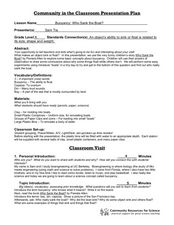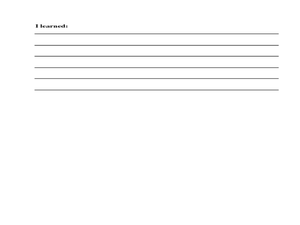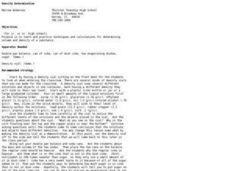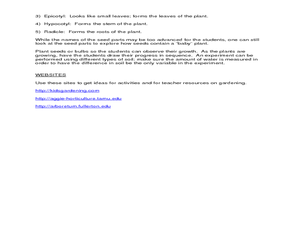Curated OER
To Float or Not to Float - A Lesson on Density
Students define density in their own words. In this physics lesson, students calculate density using mass and volume. They explain why some objects sink and some float.
Curated OER
Designing and Floating Boats
Students participate in an experiment to determine if a toy boat will sink or float. They make the boats out of different materials and determine its carrying capacity by adding pennies. They graph their findings on a classroom graph.
Curated OER
Water Density
Young scholars identify and analyze the concept of density using the formula, density equals mass divided by volume. They review the differences in salinity levels of the ocean and note that the changes in density are caused by wind and...
Curated OER
The Buoyancy Factor
Students examine why some objects float in water while others sink and the ability of something to float does not depend entirely on its weight. Archimedes' principle is introduced and buoyant force is discussed. Practice calculations...
Curated OER
Buoyancy: Who Sank the Boat?
Students examine whether objects will sink or float. In this buoyancy lesson students bring in objects and experiment to see if they sink or float.
Curated OER
Marine Debris
Learners perform experiments to examine if debris float, or blow in the wind. The effects of these characteristics on the marine debris are then discussed. They determine how a material can influence what becomes marine debris.
Curated OER
Marine Debris
Now is the time to educate tomorrow's citizens to care for the planet, and here is a lesson to help facilitate the process. Collect some marine debris and bring it into class. Have your class separate it into types and then test each...
Curated OER
Solve a Problem: Build a Boat
Students build a boat that float and hold as many pennies as possible, then discuss the process of building the boat and relate the experience to experiences they encounter in life.
Curated OER
Wildlife
The centerpiece of this lesson plan is a predator-prey simulation in which colored paperclips represent different species of animals camouflaged against a colored background. Relevant follow-up questions are provided. The activity is...
Curated OER
Floaters and Sinkers
Fifth graders define density as the amount of mass per volume a material contains, compare the densities of several types of materials, especially those that sink in water compared to those that float. They use two different methods to...
Curated OER
Archimedes' Principle
In this Archimedes' principle worksheet, students answer 13 questions about the concepts of Archimedes' principle such as water displacement, buoyancy and force. The answer questions from a lab they did in class to simulate Archimedes'...
Curated OER
Density and Mass
Students experiment to find which liquids are more dense. In this density and mass lesson plan, students predict and then test objects to observe and measure their density. students observe which items sink and float. Students...
Curated OER
Why Cheerios Don't Sink
Students investigate Archimedes' Principle and show how it relates to density. In this Archimedes' Principle lesson plan, students experiment with a beaker of water, a Styrofoam "boat" and a weight. They predict what will happen when the...
Curated OER
How Fish Maintain Neutral Buoyancy
In this buoyancy learning exercise, learners read about neutral buoyancy and that the downward force of gravity is equal and opposite to the upward force of water. They answer four critical thinking questions about buoyancy.
Curated OER
Density Columns
In this density worksheet, students answer 12 questions about the density of substances. They read a diagram of a graduated cylinder and determine the volume, mass of water. They interpret a diagram with three liquids and indicated their...
Curated OER
Salinity Lab
In this salinity worksheet, students simulate conditions of salt and fresh water mixing and observe the various densities of these solutions based on their salinity.
Curated OER
Rubber Duckies and Ocean Currents
Students explore marine life by conducting a rubber duck experiment. In this water currents lesson, students practice identifying latitude and longitude coordinates on a map and define the currents of major oceans. Students discuss the...
Curated OER
Matter for Minors
Students use streaming videos, web sites, and hands on activities students to explore matter. They focus on how temperature affects matter and what the particles look like in the states of matter.
Curated OER
Properties of Matter
Students describe four states of matter and their characteristics, explain thermal expansion of matter, interpret state changes in terms of kinetic theory of matter, explain relationship between temperature and volume of a gas, state...
Curated OER
Density Determination
Young scholars observe 2 demonstrations of density. In this density lesson plan, students observe a vial with various substances of different densities. Young scholars then observe the differences between a diet coke and a regular coke...
Curated OER
Feeding Frenzy
Students are divided into two teams in which its members are to gather as many objects in the pool as possible gaining points for different objects.
Curated OER
Density - An Introduction
Students experiment with objects of different densities. In this density lesson, students examine same-sized objects with different weights, then look at a teacher explanation of density. Students make wave bottles and a density jar to...
Discovery Science Center
Kindergarten Observing, Comparing and Contrasting
Although this is a science lesson, it can be adapted to help meet Common Core standards in math as well. Starting scientists describe physical properties of objects and explore three forms of water. To address the Common Core, they can...
Reach Out!
Paper Clip Sailing
Students explore water, molecules, and surface tension. In this floatation instructional activity, students discover why some objects are able to float on water as they follow the procedures included in this activity.























